
Law enforcement weapons, including the police issue shotgun, are in a constant state of evolution. I have been around this game long enough to see dump pouches give way to speedloaders; auto pistols replace revolvers, and a variety of less-lethal weapons render wooden batons obsolete. Change often takes more time than we like, but, eventually, we get it right and embrace the superior technology.
In the years following World War II, the shotgun established itself as the police shoulder weapon of choice. Pump-action shotguns, such as the Remington 870 and Ithaca Model 37, reigned supreme and were in wide use by law enforcement agencies. More recently, the paradigm has shifted and the patrol rifle has begun to encroach on the territory once dominated by the shotgun.
Some agencies have abandoned the shotgun altogether, while others limit their use to special teams or less-lethal applications. My own agency continues to field both shotguns and rifles to allow officers to choose the better tool for the task at hand.
Is the shotgun obsolete? I don’t think so since it can still dominate all but the most unusual situations. I would further submit that, at close to intermediate range, the 12-gauge police shotgun remains the ultimate power tool.
What follows is a rundown on some gear that can help make the police issue shotgun an even more formidable fighting tool. While this list is not all-inclusive, and there may be competitive products that fill a similar role, all of the gear outlined herein has much to offer. Optimized equipment in the hands of a trained officer gives him/her the ability to prevail against overwhelming odds.
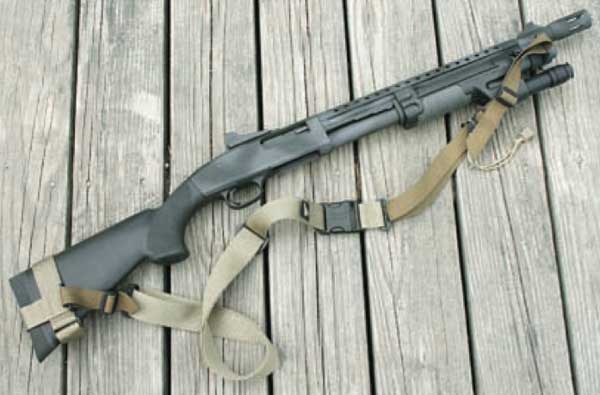
Sling It!
The single most important accessory for any shoulder weapon is a sling. A sling provides the user with a means of keeping a weapon instantly available, yet leaving the hands free to perform other tasks. In reality, a sling on a shoulder weapon serves the same purpose as a holster for a handgun. Oddly enough, we outfit our carbines and SMGs with slings but forget about our shotguns. Shotguns need slings, too!
Today, there are scores of manufacturers turning out slings in one, two, and three-point configurations. My personal favorite for shotguns is the 2 Point Tactical Sling from Specter Gear. The 2 Point Tactical Sling features comfortable, wide 1.5″ webbing across the shoulder area and a lightweight, but durable, one inch Mil-W-43688 adjuster strap. Other desirable qualities include a spring-loaded, self-locking steel adjustment cam buckle, as well as an emergency release buckle.
In the field, the user can quickly transition from a secure carry mode with the gun held tight to the body to a firing position by tugging the paracord lanyard on the adjustment cam buckle. The Specter Gear 2 Point Tactical Sling has much more to offer than a simple carry strap and helps keep your shotgun close at hand, yet instantly available for action.
Another one to consider is the CrossTac AmbiSling. Though not designed specifically for a scattergun, it could be set up to run on one. I found in my CrossTac Tactical AmbiSling Review that it was a top-quality option for supporting and carrying a long gun.
Better Sights
A good set of shotgun sights will not only enhance practical accuracy but also get you on target faster. Although a simple bead can be quite effective at the closer distances, better sights can effectively quadruple the effective range of your shotgun.
Some time ago, I became a strong advocate of ghost ring sights for the combat shogun. This setup consists of a receiver mounted rear aperture mated to a rugged front blade. Your eye will naturally center the blade in the rear aperture which “ghosts” away once you take a hard focus on the front sight. With rifled slugs, center hits on a man-size target, set a football field away, are well within the realm of possibility.
The 24/7 Tritium Stripe system from XS Sights remains a personal favorite. The rear aperture is adjustable for windage and elevation and is protected from hard knocks by a set of wings. A tritium bar highlighted with a vertical white stripe is visible in bright light, dark, and everything in between. We have this set up on several of our agency owned Remington 870s, where it continues to deliver the goods.
More recently, XS Sights has been marketing a rail with an integral ghost ring aperture which mounts to the top of the receiver of the popular 870 police shotgun. The rail gives you the ability to affix one of the popular red dot sights to your shotgun, further expanding system capabilities.
Editor’s Note
XS Sights doesn’t appear to make the stripe system for shotguns anymore. However, the integrated Ghost Ring Sight System with the Picatinny rail and the tritium front sight is still available through our affiliate link here.
A few years back, I placed an Aimpoint Micro T-1 to one of our shotguns and I can only categorize the results as incredible. The sight is clearly visible under all light conditions which improve hit potential dramatically. The T-1 is a reflex collimator, red dot sight measuring only 2.4″ and weighing 3.7 ounces. Eye relief is unlimited and this miniature optic has eight daylight, as well as four NVD settings. Battery life is 50,000 hours which translates to five years of continuous run time.
To cut right to the chase, this sight has proven to be very fast and provides the user with 100-yard capabilities. With rifled slugs, hand size spreads at 50 yards are easily achieved by a trained operator.
Editor’s Note
The Micro T1 was a first-generation optic that has been replaced by the Micro T-2. The Micro T-2 is a vastly improved sight that offers additional light transmission, a clearer sight picture and improved ruggedness. I highly recommend the sight. The best price I’ve found on the sight is through our affiliate link here.
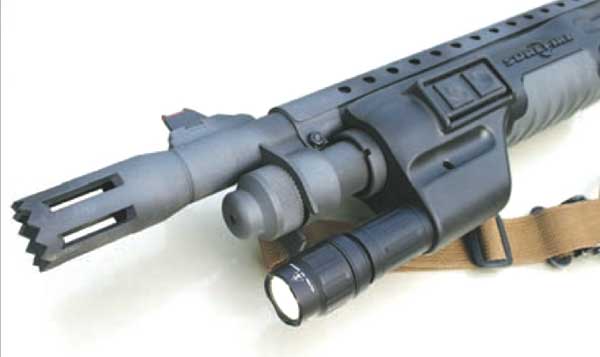
Let There Be Light
Another useful add-on for any shoulder weapon is a gun mounted light. Considering that most police action shootings take place under poor light conditions, a means of sorting out the good guys from the bad guys makes tremendous sense.
For years, SureFire, LLC has been an industry leader in illumination products. I have utilized a few different dedicated SureFire forends with integral lights on my shotguns and they have proven to be a real asset. Currently, I have a SureFire 623LM Weapon Light affixed to my Mossberg 590.
The 623LM puts out an intense 200 lumens of white light from its LED lamp. A pair of 123A three volt lithium batteries yield two hours of run time.
Two switches are integrated into this forend unit, including a momentary pressure switch on the right side and a constant-on rocker switch on the left. This unit is virtually cop proof and built to withstand the hard knocks of the real world. When working in poor light, the 623LM Weapon Light will help you make informed decisions and get you on the threat fast.

Mossberg has recently teamed up with L3 Insight Technology and now offers a pair of factory light with a 90 minute continuous run time. The shotguns with an integral forend light. Available ambidextrous side touch switch features temporary on, constant on, and strobe settings. The Insight unit puts out 125 lumens of white light. Power is supplied by a single three-volt lithium battery contained in the rear of the forend. This unit is also available from Insight Technology as an aftermarket accessory for Mossberg and Remington pump-action shotguns.
Editor’s Note
After this article was written, SureFire’s patent on attaching a flashlight to the forend of a shotgun expired. As a result, we now have competition in this area and police officers are benefitting.
Currently, the best forend light is the Streamlight TL-Racker. It is rated at 1,000 lumens and 20,000 candelas. Read our article Streamlight’s New TL-Racker Shotgun Forend Light for additional details.
Carry Spare Ammo
How much spare ammo for the police issue shotgun does the average patrol officer carry? Unless it’s on the gun, probably none! I’ve never been fond of the nylon butt cuffs or looped slings for carrying extra ammunition. The dual shell carriers which snap over the top of the duty belt can work, but many officers simply don’t have enough real estate left to work with.
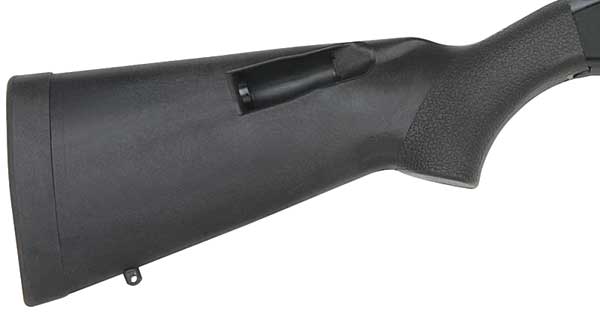
By far, the best solution is to have extra rounds in a carrier mounted directly to the gun. Mesa Tactical markets a variety of shotshell carriers for Benelli, Mossberg, and Remington shotguns which have proven to be a cut above. SureShell Shotshell carriers are available in two different styles. The first is a traditional format that mounts securely to the left side of the receiver. As an alternative, Mesa Tactical offers a saddle rail which combines a shotshell carrier with a MIL-STP-1913 Picatinny rail.
I have used both configurations and they come highly recommended. Unlike inferior carriers, shells stay put until needed. This setup also gives the user the capability of having buckshot in the gun and slugs at the ready. If a threat presents itself in the distance, the trained user can simply select the appropriate type of ammunition and deal with the problem.
Proper Stock Fit
The biggest obstacle to police shotgun efficiency is improper stock fit. Most off-the-rack shotguns are equipped with buttstocks with a 13 7/8″ to 14″ length of pull. The length of pull is defined as the distance between the rear of the buttstock to the trigger’s front surface. This longer length of pull may work for large individuals engaged in sporting applications but is entirely inappropriate when wearing soft body armor and taking a more squared-off shooting stance. Longer stocks are especially difficult for small stature shooters to manage, as it becomes impossible to achieve a proper mount and cheek weld.
Common remedies for a stock that is too long include retrofitting a youth-sized stock with a reduced length of pull or an adjustable length M-4 style stock. Mesa Tactical makes a line of quality telescopic stocks for Mossberg, Remington, and Winchester shotguns. A variant that includes an integral recoil buffer is also available. With this style of stock, the end-user can quickly adjust the fit to accommodate body type, clothing, or shooting position.
More recently, I became acquainted with Mesa Tactical Urbino Tactical Stocks. The Urbino stock is a fixed length, pistol grip unit with a 12 1/2″ length of pull. It features a Santoprene rubber grip, optional LimbSaver buttpad, optional cheek riser, and a number of options for mounting a sling. Urbino stocks are available for the Benelli Nova pump-action, Benelli autoloaders, the Remington 870, and the Remington Versa Max.
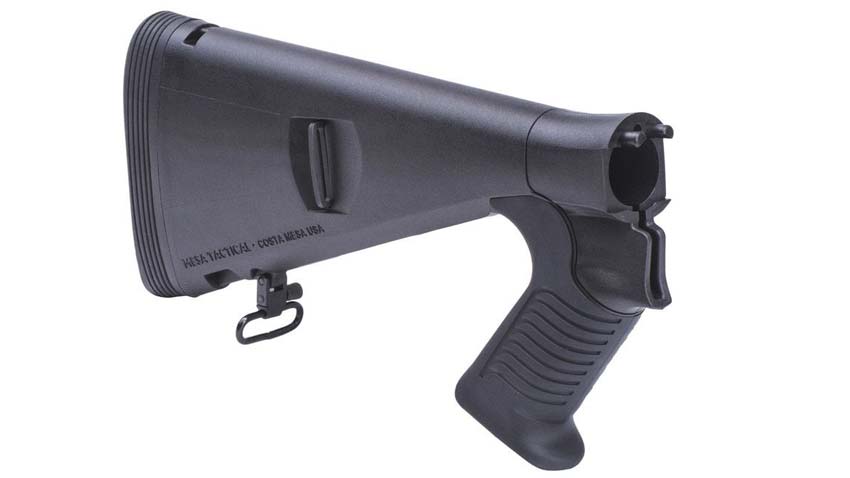
A few months back, I set up one of our agency 870s with an Urbino stock to better accommodate one of our female officers. While the factory stock was a tad too long, the Urbino was a perfect fit. Her confidence, performance, and comfort level are all very much improved.
For users who require a shorter length of pull stock in a traditional configuration, consider the OverMolded shotgun stock from Hogue, Inc. This stock features an abbreviated 12 inches of pull which is perfect for many small stature individuals. A rubber pistol grip and soft rubber recoil pad represent other nice touches. I have this stock fitted to a Mossberg 500 which I often use as a loaner and it also comes highly recommended. Hogue’s OverMolded buttstock is available for Mossberg, Remington, and Winchester shotguns.
Street Stoppers
For many years, there wasn’t a dime’s worth of difference between shotgun ammunition used for hunting and that used for law enforcement applications. That began to change about 20 years ago and now all of the major manufacturers are marketing buckshot and slug loads designed specifically for police use.
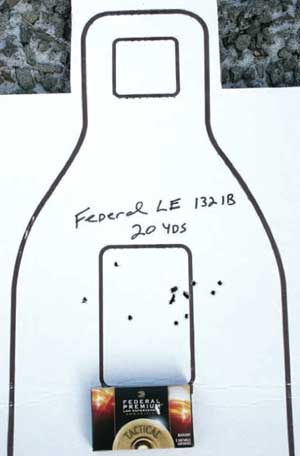
Buckshot remains the most popular load selected for police service. A short time ago, Federal Premium Ammunition introduced an improved version of their LE132 00 Tactical buck round which utilized the revolutionary FLITECONTROL wad. From an open choke shotgun, this load will reliably place all nine pellets in the chest of a man-sized target set 20 yards away. This not only enhances stopping power but also minimizes risk from errant pellets striking bystanders.
Federal has now introduced LE132 1B, a purpose-built police load which contains 15 pellets of #1 buck. Advantages include a denser pattern with a greater number of impacts on a threat. These smaller .30 caliber pellets will punch through 12″ or more of ballistic gelatin, the optimum depth of penetration established by the FBI. This low recoil load is easy on the shoulder, yet should prove very effective on the street.
I have long been a fan of rifled slugs in the police tactical shotgun. When combined with a good set of sights, the trained user has limited rifle potential and can reach out and touch targets far beyond the practical handgun range. Stopping potential with rifled slugs is also very high.
Despite giving one the ability to reach out a bit further, slugs can also defeat light cover. Depending on your perspective, this can be a good thing or a bad thing. In certain environments, the total penetration of objects or felons can be problematic. In my experience, a rifled slug will pass through a deer and exit about half the time. I wouldn’t expect performance on humanoids to be much different.
Last year, Winchester Ammunition introduced the PDX1 12 Defender Segmented Rifled Slug which might address concerns relative to overpenetration. This slug features programmed notches on the outside of the slug to ensure expansion and segmenting on impact. At an industry shoot, this innovative slug performed as advertised when fired into ballistic gelatin. After passing a short distance, the slug broke apart with each of the three segments creating its own independent wound channel and causing massive destruction.
From my 18 inch barrel S&W 3000 shotgun, muzzle velocity averaged 1444 feet per second. Five shot clusters from 50 yards were in the 3-4″ range.
Should you want to go the other way for maximum penetration, consider the various slug offerings from BrennekeUSA. Brenneke loads several different options, but my favorite is the Special Forces Short Magnum. This 1 1/4 ounce slug is exceptionally hard and will punch through 36″ of calibrated ballistic gelatin. Performance against common barriers is also impressive.
Truth be told, the Special Forces Short Magnum is not for the recoil sensitive and I might suggest Brenneke’s Tactical Home Defense load for general use. This one-ounce slug generates far less felt recoil, but with almost 3/4 of an inch of frontal area, it would still be very effective in shutting down a determined adversary.
System Upgrade
There are any number of shops performing custom shotgun work, but, like many things in life, one is well-advised to tread carefully and do your research. It will be the rare outfit, indeed, which issues a heavily customized shotgun to its patrol officers, but there are a number of upgrades worth considering.
Hans Vang has been in the gunsmithing business since 1975 and the work he performs on shotgun barrels is truly incredible. Most police tactical shotguns have no choke constriction and a traditional buckshot pattern will typically spread one inch for every yard the shooter is from the target. At 20 yards, one can anticipate some pellets missing the target entirely. In real life, this equates to diminished stopping power and increased liability.
The Vang Comp System changes all that and, by back-boring the barrel, lengthening the forcing cone, and adding compensation ports, patterns are much improved with hand-sized groups at 25 yards being the norm. Felt recoil and muzzle rise are also brought into check. Hans also turns out some very classy packages built on the Remington 870, Remington 11-87, and Mossberg 590.
The Robar Companies, Inc. of Phoenix, Arizona, is yet another firm specializing in the combat shotgun. Robar is noted for its hi-tech metal finishes, including Roguard and NP3. Roguard is a very durable black finish that is highly resistant to corrosion. Another Robar exclusive is NP3 which is best described as nickel/Teflon coating. NP3 is self-lubricating and surfaces coated with NP3 have a slippery feel and clean up very easily. By going with Roguard on the external surfaces and NP3 on the bolt and action bars, one can create a superslick, pump-action shotgun that can stand up to all sorts of abuse, including marine environments.
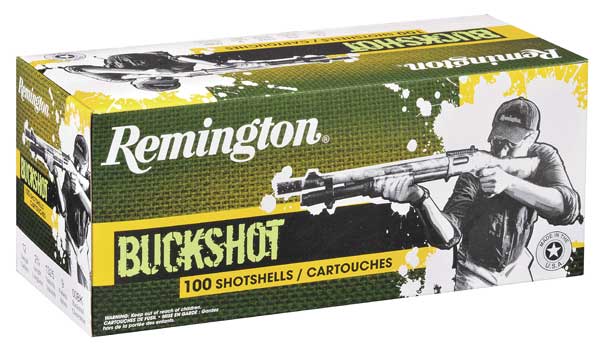
It All Comes Down to Training
Having the right hardware is great, but, in the end, it all comes down to training. Unfortunately, many police agencies do not provide adequate training on the shotgun, and, as a result, performance suffers. Swapping out shotguns for rifles will not help if the same cursory level of training is also offered on that system.
There are several shooting schools that offer comprehensive training programs on the combat shotgun which are well worth exploring. While instructional videos cannot replace hands-on training by a good instructor, they are a great supplement. One of the best is Shotgun Operator from Panteao Productions’ Make Ready series. This informative video features Bill Jeans, owner/operator of Morrigan Consulting and former Operations Manager and Chief Rangemaster for Gunsite. It is a treasure trove of solid information and offers sage advice on technique, equipment selection, and training drills.
Don’t write off the police shotgun as obsolete. Combined with a trained user, proper mindset, and equipment, it still gets the job done.
This article originally appeared in Police & Security News. It is reprinted here with permission.
Disclaimer
BlueSheepdog.com is a for-profit website. I do not charge readers a dime to access the information I provide.
Some of the links on this page and site are affiliate links to companies like Amazon and Palmetto State Armory. These links take you to the products mentioned in the article. Should you decide to purchase something from one of those companies, I make a small commission.
The links do not change your purchase price. I do not get to see what any individual purchases.